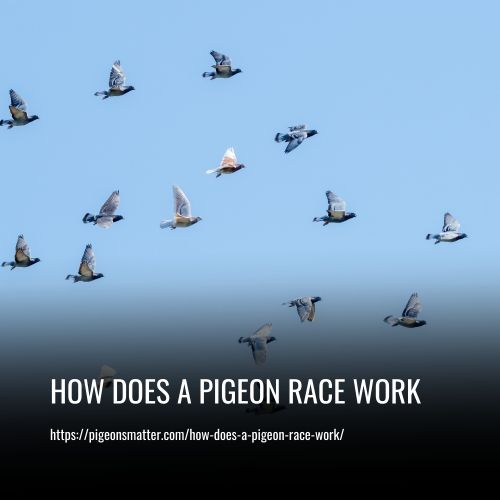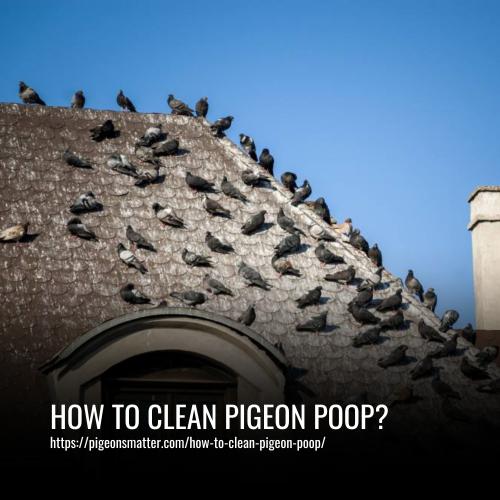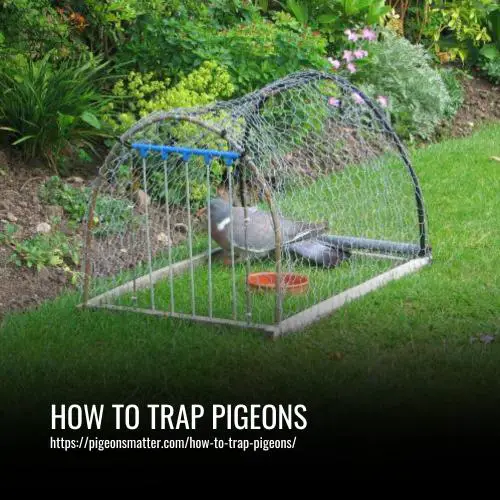A pigeon race typically involves releasing pigeons from a specific location and then timing how long it takes for the pigeons to return to their home loft. The distance of the race can vary, ranging from shorter distances of a few hundred kilometers to longer distances of several thousand kilometers.
Pigeon racing is a sport that requires precision, dedication, and training from the fancier. When a racing pigeon is about six days old, a life ring with a unique number and association details is slid onto the bird’s leg. Then, the young pigeon is trained to fly around its loft with other members of the young racing team, before gradually being taken to longer distances and becoming fit to race.

Useful steps to race a pigeon:
If you are looking to race a pigeon, there are a few steps you should take to ensure a successful race.
1. Banding and Timing Devices:
Pigeons need leg bands to identify them during training and racing, and fanciers use sophisticated timing devices to record the time of their arrival at the loft. These measures are critical components of pigeon racing and prevent confusion about which pigeon returns when.
2. Race Entry and Competition:
Once the birds are trained and ready to race, they are transported to the race point and entered into a competition. The birds are released with the exact time and location noted, and the fancier awaits their return home. Distances can range from a few hundred miles to over a thousand, and the weather conditions can significantly impact pigeon racing.
3. Ethical Concerns:
While some animal rights organizations criticize pigeon racing for the potential exploitation of pigeons and the manipulation of breeding and training methods to achieve desirable results, there is no denying that the sport involves proper training and care for the pigeons. As long as the fancier provides them with adequate food, clean water, and a safe environment, and the competition is run fairly, pigeon racing can be a thrilling and exciting sport.
Are Racing Pigeons The Same As Regular Park Pigeons?
Racing pigeons may be of the same species as their park-dwelling counterparts, but they differ extensively due to selective breeding by humans for traits such as speed, endurance, and homing instinct. They are essentially thoroughbred pigeons, distinguished by their slim and athletic build, in contrast to the more plump and sturdy build of their wild relatives.
These differences are often immediately visible at a glance, with racing pigeons commonly banded or tagged for easy identification amongst other flocks. They are oftentimes expensive birds, with some breeds being sold for thousands of dollars, further setting them apart from their less glamorous and costly feral cousins.
As with other domesticated animals, racing pigeons receive optimal care, including vaccinations and regular check-ups by veterinarians, to keep them primed and fighting fit. They need extra protection from diseases and parasites, as they are more valuable as athletes than as mere scavengers.
Is Pigeon Racing Cruel?
Pigeon racing has been under scrutiny from animal rights organizations that question its alleged cruelty. However, pigeon fanciers refute these claims, stating that the health and well-being of birds is a top priority. Pigeon fanciers are known for their attachment to their birds, treating them more like pampered pets than mere athletes. They take care of their pigeons with utmost responsibility, providing them with clean accommodations, nutritious food, and fresh water.
Moreover, fanciers believe that the sport’s primary aspects, long-distance flights, and homing instincts, are innate abilities to race pigeons, instead of something that is forced upon them. They claim that pigeons excel and enjoy flying long distances, and it is in their nature to possess such skills.
Furthermore, pigeon racing has regulations and guidelines set by the Royal Pigeon Racing Association (RPRA), which strictly oversees and monitors the sport’s well-being. RPRA is quick to expel any fanciers that mistreat and abuse their birds, ensuring the safety and comfort of the birds in the sport.
How to Race Pigeons
Racing pigeons is a straightforward process, although several factors must be taken into consideration to ensure a successful race. The process typically begins with selecting the right birds; fanciers usually opt for proven, experienced birds that are healthy and have been trained well.
1. Training Pigeons for Racing: A Comprehensive Guide:
Pigeon racing is a popular sport around the world, requiring both skill and strategy from fanciers. However, it is not as simple as just buying a few pigeons and releasing them to fly back to their home. Pigeons require proper training and care to ensure they are prepared for the rigorous challenges of long-distance racing. Here’s a guide to train your pigeons for racing and increase their chances of success.
2. Providing Clean Accommodations and Proper Feeding:
To train your pigeons, it is essential to provide them with clean and comfortable accommodations that mimic their natural habitats. This will make them feel secure and want to come back home. The loft should be equipped with proper ventilation, lighting, and feeding systems to help the pigeons maintain a healthy lifestyle. It helps to keep the loft clean of waste; this can be done by adding grid in the flooring of the loft. Additionally, ensure that your pigeons get adequate food and water supply every day, according to their age, health, and training regimen.
3. Leg Bands and Timing Devices:
Pigeons need leg bands to identify them during training and racing. These bands come in different colors, making it easy for fanciers to identify their birds. Next, it’s crucial to use a sophisticated timing device on the pigeons to record the time of their arrival to the loft. This device helps the fancier to determine the speed, distance, and the order in which each pigeon enters the loft. Leg bands and timing devices are critical elements of pigeon racing and help avoid confusion about who gets back first.
4. Starting the Training Regimen:
The training regimen begins when the pigeons are four to six weeks old and are banded and vaccinated. Young pigeons are usually tame and learn to fly by flying in circles around the loft. As they grow stronger, they are taken away from the loft to start training. The general rule is to start training them from shorter distances such as half a mile away. Then take them on longer distances while increasing the distances gradually. Once the pigeons can fly back home from a distance of around 70 miles, they are ready to race. Ensure that pigeons get used to flying in most types of weather conditions, excluding heavy rain, thunderstorms, snow, and fog.
FAQs
Pigeon racing is a sport where specially bred and trained racing pigeons are released from a specific location, and the time it takes for them to return to their home loft is recorded. The pigeon that returns home with the fastest time is the winner.
To start pigeon racing, you need to find a pigeon racing club in your area. Joining a club will provide you with instructions on how to properly care for racing pigeons, how to train them, and how to enter them into races.
Racing pigeons are specially bred and trained birds that are used for pigeon racing. These birds are bred for their strong homing instincts, endurance, and speed.
Training racing pigeons involves gradually increasing the distance they fly from their home loft. The training regimen for each pigeon varies and depends on how fast the bird can fly and its experience on racing pigeons.
Racing pigeons can fly up to 1000 miles or more. However, most races are shorter, usually between 100 and 500 miles.
The winner of a pigeon race is determined based on the time it takes for their bird to return to the home loft. The bird with the fastest time is declared the winner.
There are debates about the ethical concerns within pigeon racing. However, as long as the birds are treated humanely and provided with clean accommodations, food, and water, and the competition is run fairly, pigeon racing can be considered an ethical sport.
Pigeon racing is a competitive sport that involves trained and bred pigeons being released from predetermined locations and racing back to their lofts.
Starting a pigeon loft can require some initial investment, with expenses for feed, vaccinations, equipment and infrastructure. If housing your pigeons in someone else’s loft is an option, you may incur a one-time fee or ongoing boarding fees. Overall, the cost of keeping pigeons can vary depending on several factors, but it is important to weigh these costs against the rewards of participating in this competitive and rewarding sport.
In one loft race, all the participating pigeons are kept in the same loft, raised together, trained together, and released from the same location at the same time. The objective is for the pigeons to fly back to the home loft, and the race is spread over four rounds, each round spanning a greater distance than the previous one.
After the race, pigeon owners have two options for their birds in a one-loft race. They can either pay an entry fee to transfer their pigeons to another loft for a different race or choose to return or sell their pigeon to another fancier.
In traditional pigeon racing, all participants release their birds from the same point and the goal is for each bird to make it back to their lofts. The distance between the starting point and each loft is measured precisely.
A unique rubber or electronic ring is attached to each bird and upon their return, the time taken to complete the race is recorded using a clock or computer. The club then calculates the average speed of each bird based on the distance and time. The bird with the highest average speed is declared the winner.
The easiest way to find local pigeon fanciers is to reach out to the RPRA secretary in your region. They will connect you with a local club or fancier who can help you get started in the sport of pigeon racing.
Don’t hesitate to ask questions as these enthusiasts are usually eager to assist and share their expertise with newcomers. Although pigeon racing is a competitive sport, you’ll find that enthusiasts are willing to offer their time and knowledge to help you succeed.
Conclusion:
This article has provided essential information on how pigeon racing works. From training regimens to leg bands, we have covered various aspects of the sport that can help both newcomers and seasoned pigeon racers achieve success. By understanding the types of weather conditions that impact race times and the importance of clean accommodations for a pigeon’s return, breeders can create the best environment for their racing pigeons.
Furthermore, the article has also touched on the potential revenue that one can earn from prize money and betting, which can motivate individuals looking to invest their time and resources in this sport.


